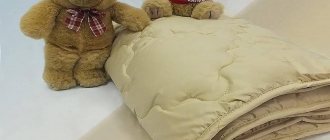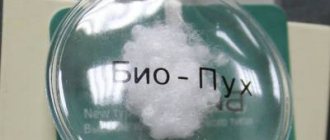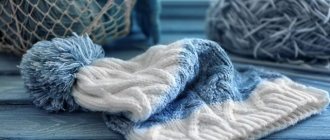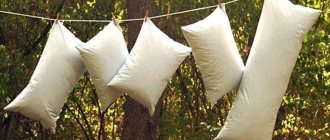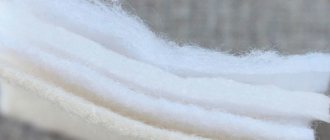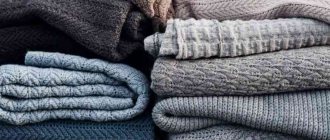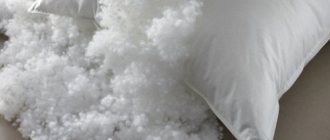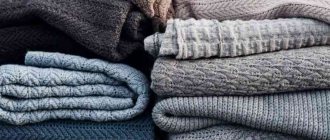Is it possible to wash a wool blanket in a washing machine? The method for restoring purity to a product depends entirely on its physical characteristics. Therefore, having decided to refresh their favorite blanket or savior from night monsters, zealous housewives first find out, using the tag on the product, the permissible and recommended method of influencing the item by the manufacturer.
- Features and types of wool blankets
- Proper care
- Preparing for washing
- Wash by hand
- We use a washing machine
- Superficial cleaning
- Drying the product
- Expert recommendations
Features and types of wool blankets
You can tell what type of blanket you are, even if the tag is no longer on it.
Types of wool blankets
Most products belong to one of the following groups:
- Solid woven. The owner may not even be aware that such a blanket is made of wool, since it looks more like a piece of dense material. If the composition of the threads and their percentage cannot be determined using the label, the presence of wool in the fabric will be indicated by the product’s ability to warm well without the greenhouse effect that acrylic or polyamide items have. And if you tear out a few threads from it and set it on fire, the ashes will begin to crumble, spreading the aroma of a burnt chicken feather.
- Quilted. This category includes blankets with a waffle-like surface or with stitching that forms a raised and intricate pattern. Thanks to the thread separators, the inner contents of the winter blanket remain evenly distributed throughout it. For any type of wool: from merino, llama, sheep, camel, the method of hygienic processing of things is the same.
- Fur. They are easily recognizable due to their fluffy surface.
Proper care
The peculiarity of the wool component of blankets is that in order to maintain a fresh aroma they must be systematically ventilated, without exposing them to direct sunlight. In winter, these things should be taken out into the cold at least once during the day, giving the hairs in the product a slight aggressive shake, which is useful for their microscopic scales. But wet treatment is only permissible for some types of bedspreads.
- Fur options are not washable in water at all. Because the product will no longer be fluffy, the fibers will gather in piles and the front surface of the thing will turn into a “clearing” with stumps of “dreadlocks” cut off at the root. All that can be done for hygienic purposes with such a thing is to carry out superficial cleaning yourself or entrust it to a dry cleaner with a very good reputation.
Are you unplugging your washing machine?Oh yes! No
- Quilted ones should not be washed either, especially in a machine. This is fraught with the loss of two things in your everyday life: a good, expensive blanket and, in fact, the machine itself, if it tries to do anything with the product that has accumulated moisture. If it is so saturated with all sorts of odors that you are already thinking about throwing it away, and there is room to tinker with such a task, try to bring it into a divine state somewhere close to an uninterrupted source of water and with the opportunity to spread thick polyethylene on the ground for laying out a blanket.
- One-piece fabrics can be washed by following a number of recommendations. It is rational to resort to the help of a machine only if the thing is so thin that after moistening it will not turn out to be an unbearable burden for the machine, and the latter has a mode of delicate influence on things.
If there is a need to remove a stain, it is better to try to clean only the problem area, rather than subjecting the entire product to wet treatment.
Blanket
What challenges await you?
Even if the manufacturer allows you to machine wash the blanket and you bought a special cleansing gel, this does not give a 100% guarantee that the desired result will be achieved. The venture may not be successful if:
- the blanket hardly fits into the SMA. You can ruin not only a bulky blanket, but also a washing machine. The product should occupy a maximum of 2/3 of the drum;
- There are holes in the canvas. It is important to stitch them up to avoid a larger tear;
- dry the product incorrectly. If you do not turn the blanket over or leave the blanket unstraightened for a long time, the item may begin to “rot” and become covered with mold. It is forbidden to hang a woolen blanket over radiators;
- start a mode with heating water to a temperature of 40°C or more. The product may be deformed.
If there are difficult stains on the blanket, they should be treated before loading the item into the machine.
For these purposes, you can use a regular sponge and dishwashing liquid. Otherwise, dirt may remain on the fabric even after the cleaning program is completed, which will undoubtedly upset the owner.
Interesting:
- Washing a down scarf in a washing machine
- How to wash a sheepskin blanket in the washing machine
- What program should I use to wash a blanket in an LG washing machine?
- Washing a large blanket in the washing machine
- Washing knitted items in the washing machine
- Washing an acrylic sweater in a washing machine
Reader comments
- Share your opinion - leave a comment
Preparing for washing
It is more profitable to tidy up blankets on a hot summer day - this way they will dry faster even without using the wringing capabilities of the machine.
- Experienced housewives wash such items with specialized products for cashmere or use shampoo for normal hair. It is better not to use ordinary gels, powders, especially laundry soap, if you want the wool to remain soft and not start to smell unpleasant or itchy. It is not worth making a strong soap solution - it is difficult to wash out the foam, in any case, and if there is an excess of it, the residue will settle on the wool and reduce the quality.
- Washing and rinsing require water at the same temperature. Therefore, if it is not possible to ensure heating of a sufficient amount for rinsing, then you should not use very warm water for the main process. Maybe just a little bit. But in any case, it should not exceed 35 degrees - unless you want to be surprised by a change in the size of the dried item and an increase in its degree of causticity.
- Light-colored items must first be shaken out well, so that moistened dust and possible particles of some pigments, for example, from chip crumbs, do not cause difficult-to-remove stains on the fabric.
wool_blankets_
tomatex_ua
vikaanna50716
sukno.by
Removing stains
Dried dirt stains can be removed by dry cleaning . To do this, the area with the stain must be thoroughly dried, then cleaned with a soft bristle brush.
Grease stains are the most common. Substances from fatty foods or sauces penetrate deeply into the material; they must be removed using hand or machine washing methods.
Stains of protein origin, such as
blood, can be removed using a 3% solution of hydrogen peroxide , applying it to the contaminated area.
Paint or varnish is removed using a solvent. However, this method can lead to discoloration of dyed wool.
The longer a stain goes on, the more difficult it is to remove it in the future.
The most universal method of getting rid of tea, coffee, and juice stains is a soap solution with foam. Shampoo, special gels or powders for wool, and laundry soap are used as foaming agents.
In order to get rid of stains, you need to:
- foam the soap solution well;
- apply foam to the contaminated area;
- rub with a soft brush or sponge;
- remove remaining foam in the cleaned area using a vacuum cleaner and a damp cloth;
- After drying, you can restore the fluffiness of the villi using a comb (for fur fabrics).
Wash by hand
This is the best option for the blanket itself, but a difficult test for the owner. The most difficult thing is to arrange a full-fledged font for a thick quilted blanket, because:
- it becomes heavier by several orders of magnitude, and even a small area of it becomes almost impossible to lift when heavily moistened;
- washing must be carried out in such a way as not to damage the arrangement of layers of wool inside the cassette cells.
In order not to strain their backs and be left with a quilted blanket after it has been wet processed, savvy housewives wash the product outside, providing film protection from contact with the ground.
Are you using citric acid?
Oh yes! No
Washing technology:
- Before spreading the item, place a reliable stick made of material that will not discolor the item after contact with water in the middle of a piece of polyethylene. In the future, the “rod” will help dry the blanket faster.
- After wetting the product over the entire surface, it is doused with a soap solution, and then they walk barefoot on top, creating a gentle mechanical effect on all layers of filler. This treatment does not affect the arrangement of layers and does not threaten wool rolling or shifting.
- After the promenade, the dirt and remaining foam are washed out with water from a hose, waiting for the streams of soapy liquid to change to clear.
- Having finished with this part, the blanket is rolled up, gently pressing to expel the water.
- Having unfolded the product, the stick under it is raised ten centimeters and held at this level with the help of bricks or other improvised means placed under both ends of the “horizontal bar”. This technique allows you to speed up the escape of moisture. As the item dries, the stick is raised higher and higher.
Washing a thin blanket also requires serious physical effort due to the significantly increasing weight of the product. However, you don’t need to rub it hard - the soap solution will remove fat and dirt accumulations, even if you just gently squeeze the item around the entire perimeter.
Army wool blanket
We use a washing machine
This option is suitable only for thin blankets - provided that the weave of the threads is tight and the product will not warp under gentle processing and gentle spinning.
Things to remember:
- You can only add things with the same fabric composition to the blanket.
- A temperature within 30 0C is quite sufficient. It is not worth setting higher values so that the temperature difference between the washing and rinsing water does not make the item prickly.
- As with hand washing, do not use fabric softeners on woolen items.
Useful tips
In order for the product to retain its original appearance and properties for a long time, it is necessary:
Try to wash the bedspread as little as possible.- Ventilate and drain it during warm periods.
- Store without plastic bags to avoid a musty smell.
- You can restore the color of yellowed wool by leaving it in water with lemon for several hours.
With proper care and respect, the blanket will provide warmth for a long time on cold winter evenings.
Expert recommendations
To ensure that the item continues to please you with its appearance and service, follow a number of easy-to-follow recommendations. More details:
- Do not soak the blanket for a long time - a quarter of an hour is enough.
- Make sure that air enters it from all sides. With heavy options, you can use a horizontal bar and spacers for the sides.
- It is better to add too little cleaning agent than to add too much.
Often, washing a wool blanket seems like a feat that not everyone is capable of. However, if you know how to tackle this matter correctly, then anything can be put in order even without resorting to the help of professional “cleaners”.
Dry cleaning – price issue
In cases where it is impossible to remove dirt on your own, there is a fear of ruining an expensive item, a blanket of such a size that it is impossible to wash and dry it yourself - dry cleaning services will provide help.
The positive aspects will be:
- consultation of specialists;
- professional cleaning;
- mobile service - the blanket will be taken to the dry cleaner directly from your home.
The cost of cleaning a 1.5-2-bed blanket in a dry cleaner will be from 1200 to 1600 rubles. Pickup is paid additionally and can cost up to 1000 rubles.
